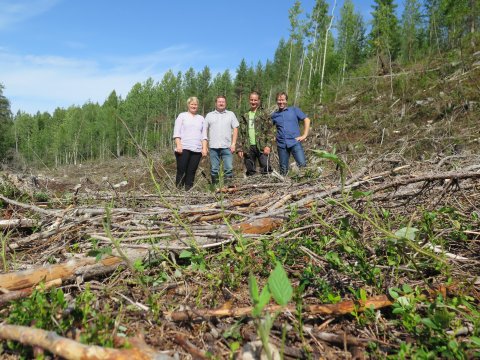On Monday 20 August, members of the Finnish Agroforestry Innovation Network met to see how landscape and forest management can be combined with sheep herding. The fieldtrip/workshop was hosted by Vaahermäen lammastila (@vaahermaki), a sheep farm in Savonranta, eastern Finland. Some quite large forest areas belong to the farm. The farm keeps Finnsheep (Suomenlammas) which graze freely in the surrounding forests throughout the whole summer from May until September.
Part of the sheep herds are also grazing on four different islands in the nearby Linnansaari National Park where they do their work in managing the traditional rural landscapes of these islands in Lake Saimaa. The forests closer to the farm are partly under commercial forest management and party managed as traditional rural biotopes. The forests surrounding the farm consist of a mosaic of mixed spruce and birch forests of different age classes.
In landscape management, sheep are excellent in keeping the landscape open and preserving its rural character. In addition, sheep can also be set to work in forest management. Sheep are natural-born forest managers as they like eating willow, rowan, aspen and alder (species which are normally removed during tending and thinning of forest stands) and leave the commercially more valuable forestry trees (pine, spruce, birch) largely untouched. At too high densities, sheep also might start eating pine and birch, but at appropriate densities, and when there is enough other deciduous browse and grass available, they will leave the pines in peace.
In Finland, birch regenerates in most cases quite abundantly anyway, so at least in these productive forests there was no problem with birch regeneration. But, of course this is site dependent, and when practicing forest grazing you have to keep an eye on it that there is still sufficient natural regeneration. Sheep usually don’t browse spruce. Because of the sheep’s feeding preference, it was possible to apply this grazing system even in very young regenerating forest stands. In this system, the farmer saves money on forest tending and thinning operations and even in this year’s extremely dry summer in Finland, he didn’t need to buy any additional food for the sheep, as there was plentiful natural forage available.
Because of the dry summer, the grazing season will probably end already in mid-September, which is two weeks earlier than in previous years. Nevertheless, the system seems quite resilient against the impacts of climate change and the farmer didn’t experience serious problems because of the for Finland rather exceptional summer drought. During the fieldtrip, we also had a workshop evaluating some of the most interesting AFINET innovations, which were identified in the project with the help of stakeholders across Europe.
More info: Michael den Herder, Innovation Broker of the Finnish RAIN












